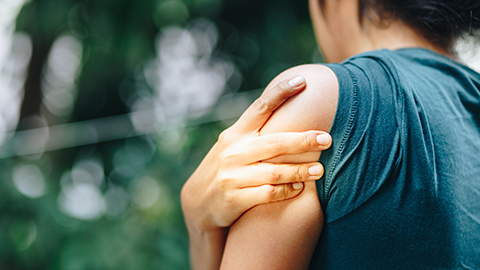
The wrong choices can lead to unforeseen repercussions. Listen as pathology expert Ruth Werner shares a story of one of her neighbors who was complaining of seemingly uncomplicated shoulder pain—that turned out not to be shoulder pain.


This episode sponsored by Anatomy Trains, Yomassage, and Books of Discovery.
00:00 Speaker 1: Ruth Werner's best-selling book, A Massage Therapist's Guide to Pathology, is a highly regarded comprehensive resource that sets the standard for Pathology Education. Written for massage therapy students and practitioners, this ground-breaking resource serves up a comprehensive review of the pathophysiology, signs, symptoms and treatment of more than 500 diseases and disorders. Learn more at booksofdiscovery.com.
[music]
00:39 Speaker 2: Hi and welcome to I Have a Client Who-Pathology Conversations with Ruth Werner, the podcast where I will discuss your real-life stories about clients with conditions that are perplexing or confusing. I'm Ruth Werner, author of A Massage Therapist's Guide to Pathology, and I have spent decades studying, writing about, and teaching about where massage therapy intersects with diseases and conditions that might limit our client's health. We almost always have something good to offer even with our most challenged clients, but we need to figure out a way to do that safely, effectively, and within our scope of practice. And sometimes, as we have all learned that is harder than it looks.
01:25 S2: In this episode, we're going to talk about a client who had a not uncommon combination of signs and symptoms that led down a surprising route for the unsuspecting massage rapist who provides this story. "I have a client who was an older lady, probably in her mid-70s, retired with her husband and living on a fixed income. They had no particular access to healthcare, they had no primary care physician. These are the kinds of folks who every year would take their RV to Mexico and stock up on all the medications they thought they might need for the year. She was generally healthy until one summer when she was working in her garden, and she had what she described to me as a fairly sudden onset of shoulder pain on her right side and pain that radiated into her mid-back and because she had been pruning her bushes at the time, she thought maybe she had strained some muscles, and so she called me to see if I could help her." Before I progress to say anything more about this case, I wanna let you guys know that if you have a good I have a client who story, you can contribute to this podcast. Send me your story at ihaveaclientwho@abmp.com, that's ihaveaclientwho, all one word, all lowercase @abmp.com, and I will look forward to hearing that from you.
03:00 S2: Back to our lady who would like to work in her garden and her shoulder is very sore. "This actually was one of my clients. And I had continued to practice massage for quite a while after I closed down my regular practice, I kept my licenses current so that I could work with friends and neighbors and students and do some pro bono work and just keep my hand in without running a regular practice. So she had called me to come and see her, and since she lived down the street from me and I had some availability, I was very happy to do that. I packed up my table, popped on over to see her, and ran her through some shoulder tests because that's what she told me, is that she had a pretty specific onset of pain in her right shoulder, and between her shoulder blades. And that's my background. When I was in practice, I really made a specialty out of working with people who had musculoskeletal injuries because I have some advanced training in orthopedic testing and assessment and treatment. So I found what I felt were some reasonably clear-cut patterns of a combination of rotator cuff injuries and tension with muscular holding that was contributing to the pain between her scapulae."
04:21 S2: "And so I told her this, I said, 'Let's work together. We'll do really short sessions, maybe half an hour, so I can really focus on your shoulder and your upper back. And we'll do that twice a week. And you should see some pretty substantial improvement within just a couple of sessions, and if you don't, then we'll have to consider something else.' So that's what we did. I worked with her once. She felt like she could move a little easier when she got up off the table, but when I went back two days later, she was worse, so I worked with her that day, and then I worked with her again on a third day and she was even worse. And at that point, I said, "Gosh, I'm really sorry. Clearly, what I'm doing is not the right thing. And so really, you're gonna need to pursue this with a doctor, and so I hope that you will do that."
05:13 S2: "And fortunately, she did, and then I didn't see her for a while. I didn't hear anything about it. I was walking by her house one day, a couple of weeks later, and she's out in her yard, pruning her rose bushes with her hands way up over her head, which she couldn't do before. And I was so excited for her. So I said, "Tell me, tell me what happened." And what I learned was that rather than having a rotator cuff injury, she had an infected gallbladder. When she got that identified and had her gallbladder removed with laparoscopic surgery, she had immediate relief from her shoulder and upper back pain and was very happily out taking care of her garden again. That's a good outcome that I had nothing to do with. If anything, I might have prevented her from getting treatment as early as she might have pursued it."
06:06 S2: "So we see a couple of interesting morals here. One is the old saw that if all you have is a hammer, everything looks like a nail. So this lady came to me, she said, 'I have shoulder and back pain. Can you help me?' And I said, 'Well, of course, I can help you.' And I did my thing for her shoulder, and I did relaxation work for her upper back, and I figured that all this muscle tension was really contributing to her symptoms, and I did what I could to relieve some of that, and it just didn't work. So one thing that I did though that was good and that I really recommend people do because of experiences like this, is when you have a client with a specific goal, set a realistic timeline in which you expect to see improvement because if you don't see it within a reasonable amount of time, then you're on the wrong track as I was, completely on the wrong track with this lady. And fortunately, A, I was able to identify that and, B, she was willing to jump through the hoops that were complicated, but that were needed for her to get the medical care that she needed. And as it turned out, that could well have been life-saving medical care. So now I wanna talk just a tiny bit about gallbladders in order to emphasize the point that this could have been a devastating mistake."
07:34 S2: "Your gallbladder, I'm sure you remember, is a little sack that hangs off, it dangles from the liver and it's job is to receive, store and concentrate bile. Bile is one of the 10 gazillion products of the liver. It is manufactured by special hepatocytes and it drips through complicated channels, and it gathers in the gallbladder. Some bile drips directly into the small intestine on a sort of constant drip, drip, drip kind of a way. But most of our bile enters the gallbladder where it is stored and concentrated, and we hold on to that until we need it. When do we need bile in the small intestine? We need bile in the small intestine when we have eaten something with a lot of fat, because what bile does is it emulsifies fats, that means it holds fat particles in suspension so that they don't clump together. And that gives our digestive enzymes better access to break down these clumps of fatty material so that we can absorb those important nutrients through the villi and into the lacteals that line the small intestine. The gallbladder and the liver join together in the gallbladder duct, but later in that duct, by later, I mean like an inch later, the pancreas adds its digestive secretions into that duct system."
09:04 S2: "So that by the time it all gets into the small intestine, we have bile directly from the liver, we have bile from the gallbladder, and we have pancreatic juices all entering the duodenum at the same spot so that we can digest the food that we're eating. Here's the thing though. If something interferes with function anywhere in that duct system, we can get in really big trouble, and that can happen pretty fast. The fact that this lady had an infection in her gallbladder and it persisted for several days before she pursued medical treatment for it, speaks to how subtle this can be. And I'll get back to the pain patterns with this and why she wasn't hurting where we would think in a minute. Most of us probably have some amount of what is called bile sludge, that is super concentrated bile that turns into little grains or grit-like sand. Sometimes the bile that's in the gallbladder can coalesce into crystals. The crystals are sort of smooth-sided, I'm looking at a picture of them now, they look sort of like pomegranate seeds. And the gallbladder can develop these stones and that might be completely silent. But if a stone lodges in a duct anywhere in that system, so that it blocks the gallbladder or blocks the liver or worst of all, blocks the pancreas, we are in big trouble. If bile cannot drain out of the liver, then it backs up through the system, we call this Jaundice, and it interferes with liver function."
10:44 S2: "If the pancreas is blocked and its digestive juices cannot exit into the small intestine, the pancreas can actually auto-digest, it can dissolve literally under the power of its own digestive juices. This is a form of acute pancreatitis, and this can be life-threatening. And then the thing that could have happened with my neighbor is because she had an untreated infection that was getting progressively worse, it is conceivable that her gallbladder could actually have abscessed and that even possibly ruptured. This would lead to peritonitis, again, a potentially life-threatening complication. So a good thing happened in that I was able to say, 'My work isn't working for you, you need to pursue this with your doctor,' and then she did it. That's her good work and that combination of good decisions really saved her life. But the big question I hope some of you are asking is, 'Well, why didn't it hurt where the gallbladder is?' And I am now... This year, I probably joined the ranks of people who are living without a gallbladder because I had cholecystitis, so I had an inflamed gallbladder because of a lodged stone, which was then, you know, the whole thing was promptly removed and I came through without any complications."
12:04 S2: "And I will tell you, this is called biliary colic, when that happens, and it hurts like crazy, and it hurts in your gut and it hurts in your shoulders, and it hurts in your back, it hurts everywhere. But the gallbladder is wired in the nervous system in such a way that it often refers pain to the shoulder and between the scapulae, specifically to the right shoulder, and between the shoulder blades. And that was the version of pain that this person, this neighbor of mine perceived. And so she wasn't having gut pain, she wasn't having indigestion, she was just having shoulder pain that got progressively worse. And even though I was working with all of the musculature around her shoulder and her upper back, she wasn't getting any better. And so that led us down this other route. So the takeaway from this is, A, gallbladders refer pain to the right shoulder, and between the shoulder blades and that's important information to know. And B, if what you're doing isn't getting the results that you're looking for, it's time to do something else. Change your tactics or refer out, or go back and reconsider what are the contributing factors to your client's issues that are interfering with their ability to progress toward their goals." And that's what I've got for you on gallbladders and shoulder pain with this episode of I Have a Client Who.
13:41 S2: Hey everybody, thanks for listening to I Have a Client Who-Pathology Conversations with Ruth Werner. Remember, you can send me your I have a client who stories to ihaveaclientwho@abmp.com, that's ihaveaclientwho, all one word, all lowercase @abmp.com. I can't wait to see what you send me and I'll see you next time.
14:09 S1: Yomassage is now offering ABMP Podcast listeners $100 off their 25-hour certification from now until September 1st with the code ABMP100. Don't miss this opportunity to take advantage of the biggest discount Yomassage has ever offered. Yomassage is revolutionizing the wellness industry by combining therapeutic touch, mindfulness, and restorative stretch. Take your career to the next level and become a certified Yomassage therapist. Learn more at yomassage.com.
[music]
14:48 S1: Anatomy Trains is excited to invite you to intro to craniosacral therapy, live online with Lauren Christman, August 8th and 9th. This eight-hour live online course introduces basic craniosacral principles and methods, giving you a taste of this work within a structural bodywork approach. You'll receive a general overview of the anatomy and physiology of craniosacral therapy and practice techniques to develop sensitive hands and the inner stillness that anchors this healing art, the perfect skill to add to your toolkit to help clients relax in stressful times. Visit anatomytrains.com and click on Advanced Summer Courses for details.